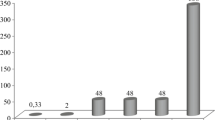Conclusions
The influence of hydrostatic pressing with pressures up to 2.0 GPa of powder obtained by the sol-gel method on phase transformations in sintering and the properties of the sintered material in the Al2O3-SiO2-ZrO2 system has been studied. It was shown that an increase in hydrostatic pressing pressure from 0.3 to 2.0 GPa makes it possible to significantly increase the density and strength of the sintered material. In this case the primary factor hindering development of high strength is the increased pore size in the sintered material.
It was observed that an increase in hydrostatic pressing pressure of the powder leads to acceleration of decomposition of zircon and formation of mullite. These processes are accompanied by broadening of the x-ray lines of the newly formed phases.
The two-stage character of the sintering process was shown on the basis of the relationships of density and strength of the investigated material to sintering temperature. The conclusion that the low-temperature stage is caused by phase transformations in the sintering process and the high-temperature by diffusion processes in the newly formed phases was drawn.
The possible mechanism leading to appearance of the observed effects were considered.
Similar content being viewed by others
References
A. Leriche, “Mullite and mullite matrix composites,” in: Proceedings of the International Conference on Mullite, Tokyo, 1987, American Ceramic Society, Westerville, Ohio (1990), (Ceramic Transactions, Vol. 6), pp. 541–552.
G. Orange and G. Fantozzi, “High-temperature mechanical properties of reaction-sintered mullite/zirconia and mullite/alumina/zirconia composites,” J. Mater. Sci.,20, No. 7, 2533–2540 (1985).
V. L. Balkevich, Technical Ceramics [in Russian], Stroiizdat, Moscow (1984).
A. A. Dabizha, V. V. Moiseev, N. A. Dabizha, et al., “The influence of hydrostatic compression on the processes of compaction and sintering of corundum castings,” Ogneupory, No. 4, 6–9 (1988).
A. A. Dabizha, A. V. Prokof'ev, G. Ya. Akimov, et al., “The role of hydrostatic pressing information of the structure and properties of a reaction-bonded ceramic of mullite and zirconium dioxide,” Ogneupory, No. 4, 24–27 (1989).
V. V. Storozh and G. Ya. Akimov, “The influence of hydrostatic processing of the powder on the physicomechanical properties of sintered magnesium oxide,” Ogneupory, No. 5, 13–15 (1992).
A. G. Evans and T. G. Lengdon, Constructional Ceramics [Russian translation], Metallurgiya, Moscow (1980).
J. M. Low and R. McPherson, “Crystallization of gels in the SiO2-Al2O3-ZrO2 system,” J. Mater. Sci.,24, No. 5, 1648–1652 (1989).
G. Ya. Akimov, V. V. Storozh, and G. K. Volkova, Initiation by High Hydrostatic Pressure of Sintering Processes and Phase Transitions in Oxides: A Preprint [in Russian], Donetsk. Fiz.-Tekh. Inst. Akad. Nauk UkrSSR, Donetsk (1990).
Y. Kanno, “Thermodynamic and crystallographic discussion of the formation and dissociation of zircon,” J. Mater. Sci.,24, No. 7, 2415–2420 (1989).
J. A. Pask, in: Proceedings of the International Symposium on Hydrothermal Reactions, Tokyo, 1982, Asses Sci. Doc. Inf., Tokyo (1983), pp. 904–918.
N. A. Dabizha, V. V. Strozh, G. Ya. Akimov, and A. A. Dabizha, “The influence of medium in mechanical activation of powder on formation of a reaction-bonded ceramic in the thyalite-mullite-corundum system,” Ogneupory, No. 2, 12–15 (1993).
Ya. E. Geguzin, The Physics of Sintering [in Russian], Nauka, Moscow (1984).
J. Christian, The Theory of Transformations in Metals and Alloys [Russian translation], Part 1, Mir, Moscow (1978).
V. V. Skorokhod and S. M. Solonin, Physicometallurgical Fundamentals of Sintering of Powders [in Russian], Metallurgiya, Moscow (1984).
Author information
Authors and Affiliations
Additional information
Translated from Ogneupory, No. 12, pp. 13–17, December, 1993.
Rights and permissions
About this article
Cite this article
Storozh, V.V., Akimov, G.Y., Labinskaya, N.G. et al. Influence of hydrostatic pressing of a sol-gel obtained by a powder method on the sintering and properties of ceramics in the Al2O3-SiO2-ZrO2 system. Refractories 34, 596–601 (1993). https://doi.org/10.1007/BF01292746
Issue Date:
DOI: https://doi.org/10.1007/BF01292746




